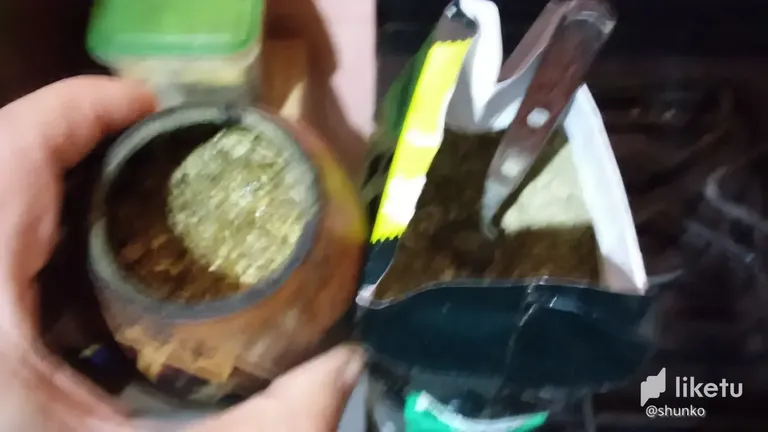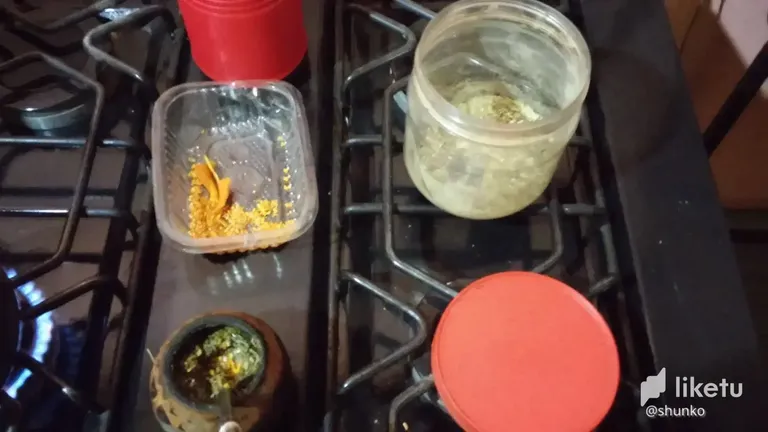
There are an infinite number of yerba brands on the market. / Hay una infinita cantidad de marcas de yerba en el mercado.

Good rules recommend filling the mate halfway and adding warm water so as not to "burn" the yerba. / Las buenas normas aconsejan llenar el mate hasta la mitad y agregarle agua tibia para no "quemar" la yerba.


Then fill the container -mate- up to 3/4 of its capacity and complete with the already hot water. / Luego llenar el recipiente -mate- hast 3/4 de su capacidad y completar con el agua ya caliente.

The first mate is generally discarded to allow the yerba to moisten well and reach the right temperature. / El primer mate generalmente es desechado pra dejar que la yerba se humedezca bien y tome la justa temperatura.

The yerba can be flavored with fruit peels -in my case- or aromatic plants -mint, lemon verbena, etc. / La yerba puede ser aromatizada con cáscaras de fruta -en mi caso- o plantas aromáticas -menta, cedrón, etc.

The ideal water temperature for mate should be approximately 80°. / La temperatura ideal del agua para el mate debería ser de 80° aproximadamente.

A mate "with the foam" is the best sign that the yerba has not been "burned" with the water that is too hot. / Un mate "con la espuma" es la mejor señal que la yerba no ha sido "quemada" con el agua demasiado caliente.

Accompanying the mate with sweet cookies or biscuits. / Acompañando el mate con galletitas dulces o bizcochos.

In my usual job sitting in front of the PC mate in hand. / En mi trabajo habitual sentado delante del PC mate en mano.
There are beverages and foods that are so integrated into the identity of a country that they become a sort of "national symbol" that identifies not only the country or countries that consume it, but also has true cultural connotations.
If we speak of Italy, we must necessarily refer to coffee, the true driving force and regulator of the economy in general - its price is a true indicator of the variation in consumer prices. Spain has its paella and its pinches as appetizers. The U.S. is the kingdom of the hamburger, and so the list goes on and on.
In the extreme south of the American continent there are three countries that dispute the consumption of a popular drink that has crossed the centuries to reach the current era, with more presence than ever: it is the mate and the countries are Argentina, Uruguay and Paraguay.
In fact it is the latter country that gives the scientific name to the yerba mate plant (Ilex paraguariensis) whose cut and ground leaves are used for the preparation of the traditional mate. The natural bitter color is given by the tannin contained in the leaves.
Due to the amount of water that is consumed (in my case the mate is quite large) has an important diuretic effect apart from the stimulating effect it has by the energizing it possesses. Until a few decades ago it was called "mateine" and was considered a step below "theine", the energizer of tea.
Current studies have determined, however, that it has a variant of "caffeine", which is why if the person is not used to it and drinks it in the afternoon a few hours before going to sleep, he/she will probably have some difficulty in falling asleep.
As for me, I have the habit of drinking it while I work at the PC around noon and a couple of hours before lunch. This way it does not make me sleepy. Other people drink it as soon as they get up. And others drink it all day long.
It is common to see people on the streets with the thermos in one hand and the mate in the other, visiting stores, looking in shop windows, attending cultural and sporting events, etc. The thermos keeps the water hot for as long as necessary. Since it was declared the national drink in Argentina, commercial marketing has exploded and there are countless varieties of mates and thermoses, sometimes all the elements incorporated in one, precisely to simplify transportation.
It is also common to find bags with spaces specifically dedicated to the thermos, the mate, the bombilla and the yerba container. And also large rooms, in camping sites, called "materas" where people can go to prepare mate, with tables and chairs to sit and have a conversation among friends.
Traditionally, mate is a moment of rest and relaxation at work and for decades, when these countries had an eminently agricultural economy, it was drunk before starting work, before lunch at noon and in the afternoon, never during work. Later in modern times it is common to see how the same employees, especially in public offices, drink mate while working.
In 2013 mate was declared a national infusion in Argentina, while Uruguay is the largest consumer of yerba mate in the world in percentage terms. When the Spanish conquistadors arrived in this part of the American continent, they discovered that the Guarani Indians used the leaves of yerba mate as a beverage and traveled great distances without showing signs of fatigue, demonstrating great endurance. To this end, they began to take it themselves, believing in its beneficial properties.

El mate, más que una infusión es un símbolo nacional.
Hay bebidas y alimentos que se integran de tal manera en la identidad de un país que pasan a ser una especie de "símbolo nacional" que identifica no solo al país o países que lo consumen sino que tiene, a su vez, verdaderas connotaciones culturales.
Si hablamos de Italia debemos referirnos por fuerza al café, verdadero motor y regulador de la economía en general -su precio es un verdadero indicador de la variación de precios al consumidor-. España tiene su paella y sus pinches como aperitivos. EE. UU. es el reino del hamburguer y así de a poco la lista va aumentando.
En el extremo sur del continente americano hay tres países que se disputan el consumo de una bebida popular que ha atravesado los siglos hasta llegar a la era actual, con más presencia que nunca: es el mate y los países son Argentina, Uruguay y Paraguay.
En realidad es este último país el que le da el nombre científico a la planta de yerba mate (Ilex paraguariensis) cuyas hojas cortadas y molidas se usan para la elaboración del tradicional mate. El color natural amargo se lo da el tanino que contienen las hojas.
Debido a la cantidad de agua que se consume (en mi caso el mate es bastante grande) tiene un importante efecto diurético aparte del efecto estimulante que posee por el energizante que posee. Hasta hace algunas décadas se lo llamaba "mateína" y se lo consideraba un escalón más abajo de la "teína" el energizante del té.
Estudios actuales han determinado, en cambio, que posee una variante de la "cafeína" razón por la cuál si la persona no está habituada y lo bebe durante la tarde pocas horas antes de irse a dormir probablemente tenga alguna dificultad en conciliar el sueño.
Por mi parte tengo la costumbre de tomarlo mientras trabajo en el PC cerca del mediodía y un par de horas antes de almorzar. De esta manera no me quita el sueño. Otras personas lo beben apenas se levantan. Y otras durante todo el día.
Es habitual ver a personas por las calles con el thermos en una mano y el mate en la otra visitando negocios, mirando vidrieras, asistiendo a espectáculos culturales y deportivos, etc. El thermos permite mantener el agua caliente el tiempo necesario. Desde que fue declarada bebida nacional en Argentina explotó el marketing comercial y hay un sinfín de variedades de mates y thermos, a veces todos los elementos incorporados en uno solo, para simplificar precisamente el traslado.
También en frecuente encontrar las bolsas con espacios dedicados específicamente al thermos, al mate, a la bombilla y al contenedor de la yerba. Y también amplios salones, en los lugares de camping, llamados "materas" donde las personas pueden ir a prepararse el mate, con mesas y sillas para sentarse y entablar una conversación entre amigos.
Tradicionalmente el mate significa un momento de descanso, de relax en el trabajo y por décadas cuando estos países tenían una economía eminentemente agropecuaria se tomaba antes de comenzar el trabajo, antes de comer al mediodía y a la tarde, nunca durante el trabajo. Posteriormente en los tiempos modernos es frecuente ver como los mismos empleados, especialmente de oficinas públicas, beben mate mientras trabajan.
En el año 2013 se declaró al mate en Argentina como infusión nacional, mientras que Uruguay en terminos porcentuales es el mayor consumidor de yerba mate en el mundo. Cuando los conquistadores españoles llegaron a esta parte del continente americano descubrieron que los indios guaraníes utilizaban las hojas de la yerba mate como bebida y recorrían grandes extensiones sin dar señales de cansancio demostrando una gran resistencia. Con ese fin comenzaron ellos mismos a asumirla creyendo en sus propiedades benéficas.
Translated with www.DeepL.com/Translator (free version)

For the best experience view this post on Liketu

